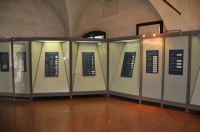The Iron Age in Vicenza
6th Century B.C. - mid-1st Century B.C.
The urban center of Vicenza was formed during the 6th century BC, in a strategic position on a bend of Astico River, near its confluence with Retrone.
The bronze votive plaques from Piazzetta S. Giacomo, near Corso Palladio, are the most important find and document the existence of an important sanctuary in the heart of the city, frequented from the late 5th century BC to Romanization (1st century BC).Many plaques are discs cut with geometric decorations; others are stamped, embossed, and engraved, depicting diseased body parts, and, above all, men and women who frequented the sanctuary in various capacities.The most numerous depictions are those of armed men and veiled women, portrayed during initiation rites. There are also naked men and women, dignitaries, priests and priestesses, girls offering libations or playing ball, athletes, and a knight.
An example of an alphabetic tablet, a reproduction on foil of actual syllabaries, documents the teaching of writing within the sanctuary.
Among the materials from the pre-Roman settlement are votive deposits of miniature vases from Contrà Pasini and the area of Santa Corona, and a fragment of a horse-head andiron with incised decoration, also from the area of Santa Corona.
Image Gallery
 |

